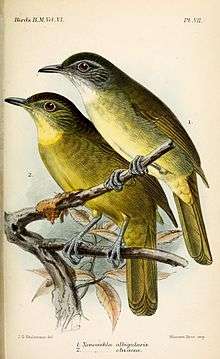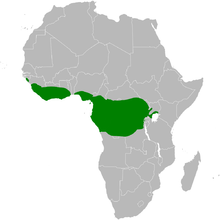Criniger
Criniger is a genus of songbirds in the bulbul family, Pycnonotidae. The species of Criniger are found in western and central Africa.
| Criniger | |
|---|---|
 | |
| White-bearded greenbul (above) and yellow-bearded greenbul (below) | |
| Scientific classification | |
| Kingdom: | Animalia |
| Phylum: | Chordata |
| Class: | Aves |
| Order: | Passeriformes |
| Family: | Pycnonotidae |
| Genus: | Criniger Temminck, 1820 |
 | |
| Synonyms | |
| |
Taxonomy and systematics
Established by Coenraad Jacob Temminck in 1820, the name Criniger is Latin for "long-haired" (from crinis, meaning "hair" and gerere, meaning "to carry").[1]
Extant species
There are five extant species in the genus Criniger:[2]
- Western bearded greenbul (Criniger barbatus)
- Eastern bearded greenbul (Criniger chloronotus)
- Red-tailed greenbul (Criniger calurus)
- White-bearded greenbul (Criniger ndussumensis)
- Yellow-bearded greenbul (Criniger olivaceus)
Former species
Formerly, some authorities also considered the following species (or subspecies) as species within the genus Criniger:
- Striated bulbul (as Tricophorus striatus or Criniger striatus)[3][4]
- Streak-eared bulbul (as Criniger Conradi)[5]
- Western greenbul (as Trichophorus tephrolaemus)[6]
- Olive-headed greenbul (as Criniger olivaceiceps)[7]
- Golden greenbul (as Criniger serinus)[8]
- Honeyguide greenbul (as Criniger indicator)[9]
- Upper Guinea honeyguide greenbul (as Trichophorus leucurus)[10]
- Yellow-bellied greenbul (as Trichophorus flaviventris)[11]
- Falkenstein's greenbul (as Criniger Falkensteini)[12]
- Simple greenbul (as Trichophorus simplex)[13]
- Yellow-throated leaflove (as Trichophorus flavicollis or Criniger flavicollis)[14]
- Uganda yellow-throated greenbul (as Trichophorus flavigula)[15]
- Northern brownbul (as Criniger strepitans)[16]
- Fischer's greenbul (as Criniger Fischeri)[17]
- Cabanis's greenbul (as Criniger cabanisi)[18]
- Icterine greenbul (as Trichophorus icterinus)[19]
- Red-tailed bristlebill (multicolor) (as Criniger multicolor)[20]
- Green-tailed bristlebill (as Trichophorus eximius)[21]
- Yellow-lored bristlebill (as Trichophorus notatus)[22]
- Grey-headed bristlebill (as Trichophorus canicapillus)[23]
- Finsch's bulbul (as Criniger finschi)[24]
- White-throated bulbul (as Trichophorus flaveolus or Criniger flaveolus)[25]
- White-throated bulbul (burmanicus) (as Criniger burmanicus)[26]
- Puff-throated bulbul (as Criniger pallidus)[27]
- Grey-crowned bulbul (as Criniger griseiceps)[28]
- Puff-throated bulbul (henrici) (as Criniger Henrici)[29]
- Ochraceous bulbul (as Criniger ochraceus)[30]
- Ochraceous bulbul (sordidus) (as Criniger sordidus)[31]
- Ochraceous bulbul (sumatranus) (as Criniger sumatranus)[32]
- Ochraceous bulbul (ruficrissus) (as Criniger ruficrissus)[33]
- Grey-cheeked bulbul (as Criniger bres)[34]
- Grey-cheeked bulbul (tephrogenys) (as Trichophorus tephrogenys)[35]
- Grey-cheeked bulbul (gutturalis) (as Trichophorus gutturalis or Criniger gutturalis)[36]
- Palawan bulbul (as Criniger frater)[37]
- Yellow-bellied bulbul (as Criniger phaeocephalus)[38]
- Yellow-bellied bulbul (diardi) (as Criniger diardi)[39]
- Yellow-bellied bulbul (sulphuratus) (as Trichophorus sulphuratus)[40]
- Yellow-browed bulbul (as Trichophorus indicus)[41]
- Yellow-browed bulbul (icterica) (as Criniger ictericus)[42]
- Hairy-backed bulbul (as Trichophorus minutus)[43]
- Hairy-backed bulbul (sericeus) (as Criniger sericea)[44]
- Grey-eyed bulbul (as Criniger propinquus)[45]
- Charlotte's bulbul (as Criniger charlottae)[46]
- Sulphur-bellied bulbul (as Criniger palawanensis)[47]
- Seram golden bulbul (as Criniger affinis)[48]
- Ambon golden bulbul (as Trichophorus flavicaudus)[49]
- Northern golden bulbul (as Criniger longirostris)[50]
- Sangihe golden bulbul (as Criniger Platenae)[51]
- Togian golden bulbul (as Criniger aureus)[52]
- Halmahera golden bulbul (as Criniger Chloris)[53]
- Buru golden bulbul (as Criniger mystacalis)[54]
- Yellowish bulbul (as Criniger Everetti)[55]
- Sulu bulbul (as Criniger Haynaldi)[56]
gollark: For OIR anyway.
gollark: mpd was initially just picked because it had builtin HTTP streaming, but it turned out to be a good design choice!
gollark: Basically, the entire radio system runs off a mpd instance behind a reverse proxy.
gollark: https://osmarks.tk/radio/ is its URL, see.
gollark: It's not private. It's publicly accessible. There would be no good reason to have a public bot announcing it if it wasn't.
References
- Jobling, James A. (2010). The Helm Dictionary of Scientific Names. London, UK: Christopher Helm. p. 121. ISBN 978-1-4081-2501-4.
- "Bulbuls « IOC World Bird List". www.worldbirdnames.org. Retrieved 2017-05-08.
- "Pycnonotus striatus - Avibase". avibase.bsc-eoc.org. Retrieved 2017-03-08.
- Admin, Avis (2014-09-10). "277. Alcurus striatus". AVIS-IBIS. Retrieved 2017-03-08.
- "Pycnonotus conradi - Avibase". avibase.bsc-eoc.org. Retrieved 2017-03-31.
- "Arizelocichla tephrolaema - Avibase". avibase.bsc-eoc.org. Retrieved 2017-04-03.
- "Arizelocichla olivaceiceps - Avibase". avibase.bsc-eoc.org. Retrieved 2017-04-06.
- "Calyptocichla serinus - Avibase". avibase.bsc-eoc.org. Retrieved 2017-04-11.
- "Baeopogon indicator - Avibase". avibase.bsc-eoc.org. Retrieved 2017-04-11.
- "Baeopogon indicator leucurus - Avibase". avibase.bsc-eoc.org. Retrieved 2017-04-11.
- "Chlorocichla flaviventris - Avibase". avibase.bsc-eoc.org. Retrieved 2017-04-13.
- "Chlorocichla falkensteini - Avibase". avibase.bsc-eoc.org. Retrieved 2017-04-16.
- "Chlorocichla simplex - Avibase". avibase.bsc-eoc.org. Retrieved 2017-04-16.
- Catalogue of the Birds in the British Museum: Passeriformes, or perching birds. Cichlomorphœ: pt. III-IV, containing the ... family Timeliidœ (babbling-thrushes) by R.B. Sharpe. order of the Trustees. 1881-01-01.
- "Atimastillas flavicollis flavigula - Avibase". avibase.bsc-eoc.org. Retrieved 2017-04-17.
- "Phyllastrephus strepitans - Avibase". avibase.bsc-eoc.org. Retrieved 2017-04-21.
- "Phyllastrephus fischeri - Avibase". avibase.bsc-eoc.org. Retrieved 2017-05-02.
- "Phyllastrephus cabanisi - Avibase". avibase.bsc-eoc.org. Retrieved 2017-05-02.
- "Phyllastrephus icterinus - Avibase". avibase.bsc-eoc.org. Retrieved 2017-05-04.
- "Bleda syndactylus syndactylus (multicolor) - Avibase". avibase.bsc-eoc.org. Retrieved 2017-05-07.
- "Bleda eximius - Avibase". avibase.bsc-eoc.org. Retrieved 2017-05-07.
- "Bleda notatus - Avibase". avibase.bsc-eoc.org. Retrieved 2017-05-07.
- "Bleda canicapillus - Avibase". avibase.bsc-eoc.org. Retrieved 2017-05-07.
- "Alophoixus finschii - Avibase". avibase.bsc-eoc.org. Retrieved 2017-05-12.
- "Alophoixus flaveolus - Avibase". avibase.bsc-eoc.org. Retrieved 2017-05-12.
- "Alophoixus flaveolus burmanicus - Avibase". avibase.bsc-eoc.org. Retrieved 2017-05-13.
- "Alophoixus pallidus - Avibase". avibase.bsc-eoc.org. Retrieved 2017-05-14.
- "Alophoixus pallidus griseiceps - Avibase". avibase.bsc-eoc.org. Retrieved 2017-05-14.
- "Alophoixus pallidus henrici - Avibase". avibase.bsc-eoc.org. Retrieved 2017-05-14.
- "Alophoixus ochraceus - Avibase". avibase.bsc-eoc.org. Retrieved 2017-05-15.
- "Alophoixus ochraceus sordidus - Avibase". avibase.bsc-eoc.org. Retrieved 2017-05-15.
- "Alophoixus ochraceus sumatranus - Avibase". avibase.bsc-eoc.org. Retrieved 2017-05-15.
- "Alophoixus ochraceus ruficrissus - Avibase". avibase.bsc-eoc.org. Retrieved 2017-05-15.
- "Alophoixus bres - Avibase". avibase.bsc-eoc.org. Retrieved 2017-05-15.
- "Alophoixus bres tephrogenys - Avibase". avibase.bsc-eoc.org. Retrieved 2017-05-15.
- "Alophoixus bres gutturalis - Avibase". avibase.bsc-eoc.org. Retrieved 2017-05-15.
- "Alophoixus frater - Avibase". avibase.bsc-eoc.org. Retrieved 2017-05-23.
- "Alophoixus phaeocephalus - Avibase". avibase.bsc-eoc.org. Retrieved 2017-05-29.
- "Alophoixus phaeocephalus diardi - Avibase". avibase.bsc-eoc.org. Retrieved 2017-05-29.
- "Alophoixus phaeocephalus sulphuratus - Avibase". avibase.bsc-eoc.org. Retrieved 2017-05-29.
- "Acritillas indica - Avibase". avibase.bsc-eoc.org. Retrieved 2017-06-01.
- "Acritillas indica icterica - Avibase". avibase.bsc-eoc.org. Retrieved 2017-06-01.
- The Ibis. British Ornithologists' Union. 1872.
- "Tricholestes criniger sericeus - Avibase". avibase.bsc-eoc.org. Retrieved 2017-06-03.
- "Iole propinqua - Avibase". avibase.bsc-eoc.org. Retrieved 2017-06-05.
- "Buff-vented Bulbul (Iole charlottae)". www.hbw.com. Retrieved 2017-06-05.
- "Iole palawanensis - Avibase". avibase.bsc-eoc.org. Retrieved 2017-06-05.
- "Thapsinillas affinis (Seram Golden Bulbul) - Avibase". avibase.bsc-eoc.org. Retrieved 2017-10-18.
- "Thapsinillas affinis flavicaudus (Ambon Golden Bulbul) - Avibase". avibase.bsc-eoc.org. Retrieved 2017-10-18.
- "Thapsinillas longirostris (Sula Golden-Bulbul) - Avibase". avibase.bsc-eoc.org. Retrieved 2017-10-21.
- "Thapsinillas platenae (Sangihe Golden-Bulbul) - Avibase". avibase.bsc-eoc.org. Retrieved 2017-10-21.
- "Thapsinillas aurea (Togian Golden-Bulbul) - Avibase". avibase.bsc-eoc.org. Retrieved 2017-10-21.
- "Thapsinillas chloris (Halmahera Golden-Bulbul) - Avibase". avibase.bsc-eoc.org. Retrieved 2017-10-21.
- "Thapsinillas mysticalis (Buru Golden Bulbul) - Avibase". avibase.bsc-eoc.org. Retrieved 2017-10-21.
- "Hypsipetes everetti (Yellowish Bulbul) - Avibase". avibase.bsc-eoc.org. Retrieved 2017-11-06.
- "Hypsipetes everetti haynaldi (Sulu Bulbul) - Avibase". avibase.bsc-eoc.org. Retrieved 2017-11-06.
Further reading
- Huntley, Jerry W.; Harvey, Johanna A.; Pavia, Marco; Boano, Giovanni; Voelker, Gary (2017). "The systematics and biogeography of the Bearded Greenbuls (Aves: Criniger) reveals the impact of Plio-Pleistocene forest fragmentation on Afro-tropical avian diversity". Zoological Journal of the Linnean Society. doi:10.1093/zoolinnean/zlx086.
This article is issued from Wikipedia. The text is licensed under Creative Commons - Attribution - Sharealike. Additional terms may apply for the media files.